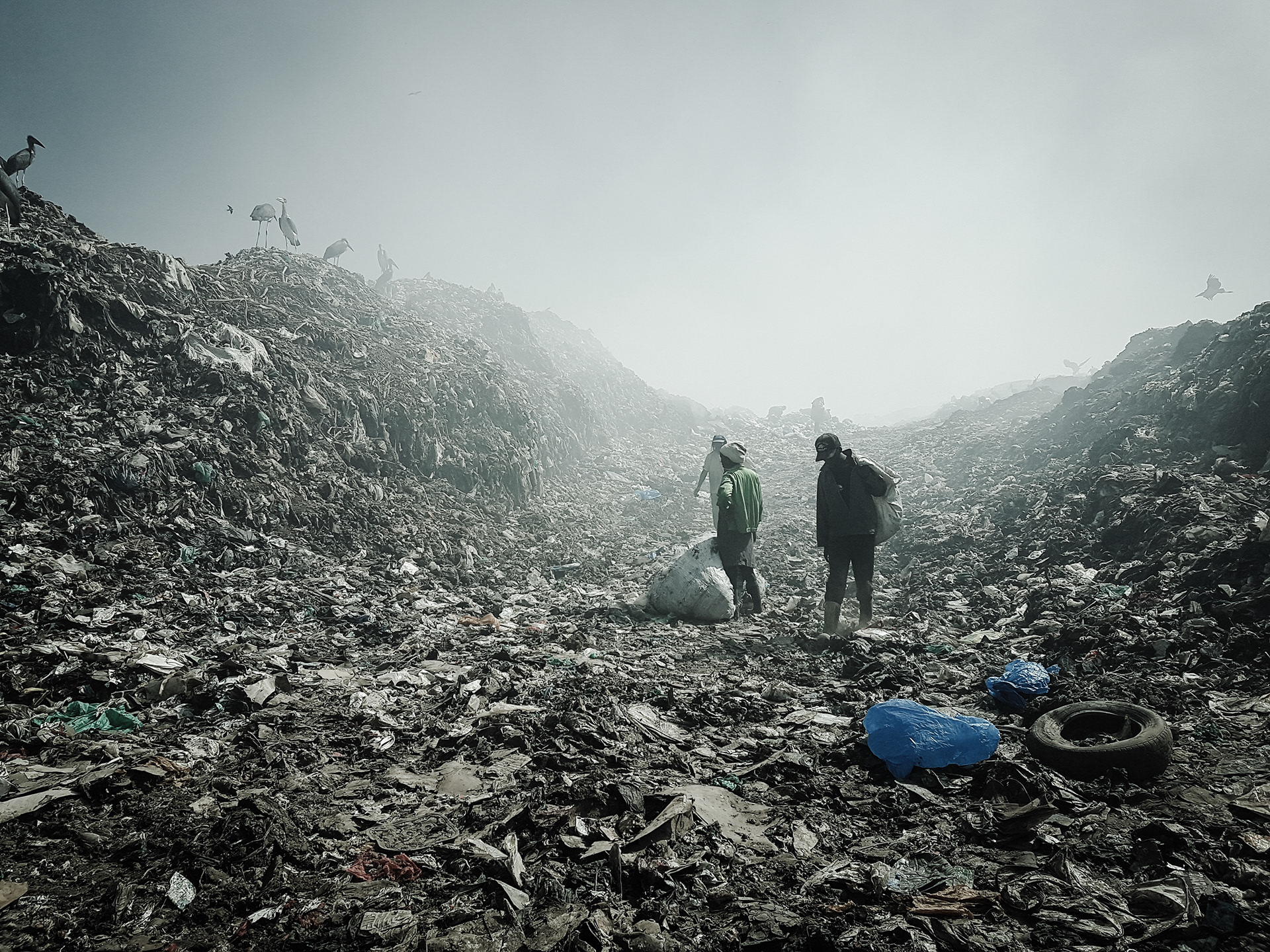Imagine this. You’re sorting through some old clothes and find a polyester-blend t-shirt from Zara or H&M that you realise you haven’t worn since last summer. You add it to the “donate” pile and then bring the whole pile of clothes to your local donation box.
You pat yourself on the back for taking the time to “recycle” it, rather than tossing it in the bin, and never think about that shirt again.
After your paths have diverged, that piece of clothing will likely go on to travel between countries and continents, and those polyester fibres may well still be swimming in the sea by the time you are underground.
Fast fashion is destroying the planet.
The volumes of clothes being made and consumed continue to increase.
Sharing, repairing and second-hand must become the new normal.
Nairobi, Kenya – @kevinmcelvaney#DetoxMyFashion pic.twitter.com/oseoYnIJ02
— Greenpeace International (@Greenpeace) April 15, 2022
But how does this happen? How can textiles that are meant to be recycled or donated in Europe end up in landfills across the world?
A recent investigation commissioned and written by the Changing Markets Foundation (CMF), with on-the-ground research carried out by Wildlight and Clean up Kenya, aims to provide an answer.
Europe’s addiction to fast fashion
In 2021, the EU exported nearly 22.5 million kg of clothing – in the form of more than 112 million individual items – to Kenya. This is only a small fraction of the total amount of clothing thrown away by Europeans each year, which totals 5.8 billion kg or about 11 kg per person.
All the while, the amount of clothing produced worldwide still continues to rise, partly to feed the growing demand for fast fashion across the world and partly thanks to a problem of systemic overproduction within the fashion industry.
This growth is being fuelled by cheap, synthetic fibres like polyester and nylon, which are essentially plastics; in fact, more than two-thirds of clothing is now made of these synthetic, plastic fibres which are impossible to recycle.
Waste from fast fashion is also the largest contributor of microplastics to marine environments; 35{05995459f63506108ab777298873a64e11d6b9d8e449f5580a59254103ec4a63} of all microplastics in the ocean originate from synthetic textiles.
As of January 2021, exporting plastic waste that is hard to recycle from the EU to non-OECD countries is banned. Nonetheless, the investigation found that a third of the clothing exported from the EU to Kenya, over 37 million items, contained plastic and was of such low quality that they immediately became waste.
Part of the statement from @ThisIsBetterman, Clean Up Kenya Founder, on release of #Trashion report with @ChangingMarkets which shows how countries in the @EU_Commission are exporting millions of rubbish plastic clothing to Kenya. We have requested for a statement from @UNEP pic.twitter.com/uQ8L4Mr1q6
— Clean Up Kenya (@CLEANUPKENYADAY) February 18, 2023
Germany was the worst offender in the EU, exporting more than 50 million clothing items in 2021, of which over 25 million were waste and almost 17 million were plastic-based fast fashion, closely followed by Poland, which exported more than 12 million plastic-based items in 2021.
What happens to the clothes in Kenya?
Kenya has a thriving second-hand clothing industry that employs millions of people off the back of these exports. These imported second-hand clothes are known as mitumba, a Kiswahili word meaning bale or bundle, because the clothing is typically sold to retailers in bales.
As part of the investigation commissioned by CMF, Betterman Simidi Musasia, founder and patron of Clean Up Kenya, says they “went to the Ground Zero of the fast fashion world to unmask an ugly truth – that the trade of used clothing from Europe is, to a large and growing extent, a trade in hidden waste.”
About 30 to 40{05995459f63506108ab777298873a64e11d6b9d8e449f5580a59254103ec4a63} of mitumba has no market value and is actually nothing more than textile waste, of which about two-thirds is typically made of plastic fibres.
Kenyan retailers of second-hand clothing consider every mitumba purchase a gamble of sorts; they have no idea how much of each bale will be able to be resold, and how much is trash, until after they have opened it and sorted through the items.
Related Articles: Fast Fashion’s Greatest Perpetrators | Ending Plastic Pollution: Talks on the First Global Treaty Begin | Fast Fashion’s Detrimental Effect on the Environment | Why Fixing Is Better Than Replacing
Every day in Kenya, about 150 to 200 tonnes of textile waste – between 60 to 75 truckloads – ends up being dumped, burnt, or sent to overflowing dump sites. Dandora, the largest landfill in East Africa, happens to sit at the edge of Gikomba Market, the bustling heart of the second-hand clothing industry in Nairobi.
Of this, Musasia says that “a large proportion of clothing donated to charity by well-meaning people ends up this way. Why? Because the backbone of the fast fashion industry is plastic, and plastic clothing is essentially junk.”

One way or another, a polyester t-shirt can continue to cause harm for years after it’s been “donated.” With no way for it to be recycled, it will most likely end up in a landfill or floating in the ocean as microplastic fibres, contributing to the disappearance of marine ecosystems.
Even in the most useful iterations of its second life, the t-shirt might be downcycled into rags or used as fuel by poor communities somewhere in the Global South, causing adverse health effects to whomever happens to be within range of the burning plastic.
CMF’s campaign manager, George Harding-Rolls says:
“Unless the fashion industry is fundamentally changed, what we have seen in Kenya and around the world will be just the beginning. Recycling companies cannot be allowed to hide behind their empty promises and should be banned from exporting junk clothing.”
Will the EU confront “hidden waste” from the fashion industry?
Although there are EU regulations in place already to restrict international export of plastic waste, the EU parliament voted in January in favour of a proposal to ban the export of all plastic waste to non-OECD countries in an effort to better address the issue.
Currently, only exporting plastic waste that is hazardous or difficult to recycle is banned.
Whether this will be effective in curbing waste from the fashion industry is unknown but unlikely. Since the plastic waste generated by fast fashion in the EU is already categorised as “difficult to recycle,” the ongoing exportation uncovered by the report is already “illegal” according to the current restrictions.
Nonetheless, the waste is still being illegally exported, hidden within bales of higher-quality clothing that will be recirculated in Kenya’s second-hand clothing markets.
However, the EU also unveiled a new textiles strategy last year, which directly targets the problems specific to waste from fast fashion and outlines a vision of the future where “fast fashion is out of fashion:”
“By 2030 textile products placed on the EU market are long-lived and recyclable, to a great extent made of recycled fibres, free of hazardous substances and produced in respect of social rights and the environment. Consumers benefit longer from high quality affordable textiles, fast fashion is out of fashion, and economically profitable re-use and repair services are widely available. In a competitive, resilient and innovative textiles sector, producers take responsibility for their products along the value chain, including when they become waste.” (bolding added)
Sustainability is the buzzword when it comes to fashion.
Our new EU textiles strategy will help the sector become more sustainable and circular, with the green transition bringing new opportunities.
Our #EUDataCrunch highlights why this matters.
— European Commission
(@EU_Commission) March 30, 2022
For now, this is one of many steps that must be taken to reduce the impact of fast fashion on the environment and vulnerable communities across the world.
However, as the second round of UN negotiations for an international legally binding agreement to end plastic pollution looms on the horizon – a UN resolution that was adopted last year at the UN Environment Assembly (UNEA-5) in Nairobi, Kenya – perhaps there is also hope that small steps like these will lead to a global end to plastic pollution.
In the meantime, the work to make the EU’s vision true by 2030 can start now; many people have the means to make a deliberate choice about the clothing that they buy, wear, and discard.
However, as long as any one of us is willing to purchase a shirt that will live in a landfill longer than it will in our wardrobes, the problem will persist.
Editor’s Note: The opinions expressed here by the authors are their own, not those of Impakter.com — In the Featured Photo: Dandora, East Africa’s largest landfill, which lies just outside Nairobi, Kenya. Featured Photo Credit: Wikimedia Commons.

